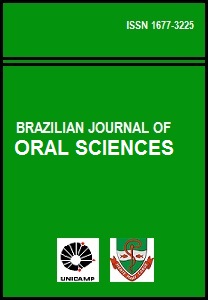Abstract
The purpose of this study was to in vitro evaluate the marginal leakage of class II composite restorations. It was utilized 30 human molar teeth with oclusal-proximal cavities, with enamel margins at the mesial and dentin at the distal sites. These teeth were divided into 3 groups (G), according to the restoration system utilized: G1 – Single Bond / Z100 (3M); G2 – Bond 1 / ALERT (Jeneric-Pentron); and G3 – Etch&Prime 3.0 / Degufill Mineral (Degussa). Epoxy resin replicas of the restored teeth were fabricated before and after thermocycling procedure. After the restoration procedure, the samples were thermocycled 500 times, covered with 2 layers of nail polish and immersed in a 2% buffered solution of methylene blue for 4 hours. After they were cut and analyzed in a microscope, where the dye penetration was measured and converted to percentage. Data were submitted to ANOVA and mean values compared by Tukey’s test. Conclusion: there were no difference between groups with restorations in enamel margins (G1=21.59%. G2=53.49%, G3= 31.58%), however in dentin margins, there was significant statistical difference (p<0.05) between G1 (18.23%) and G2 (60.08%); where G1 showed lower mean values of dye penetration. G3 (42.24%) had intermediary mean values and did not differ from the others (p>0.05). In the replicas observation it appeared that the gaps dimensions increased.The Brazilian Journal of Oral Sciences uses the Creative Commons license (CC), thus preserving the integrity of the articles in an open access environment.
Downloads
Download data is not yet available.

